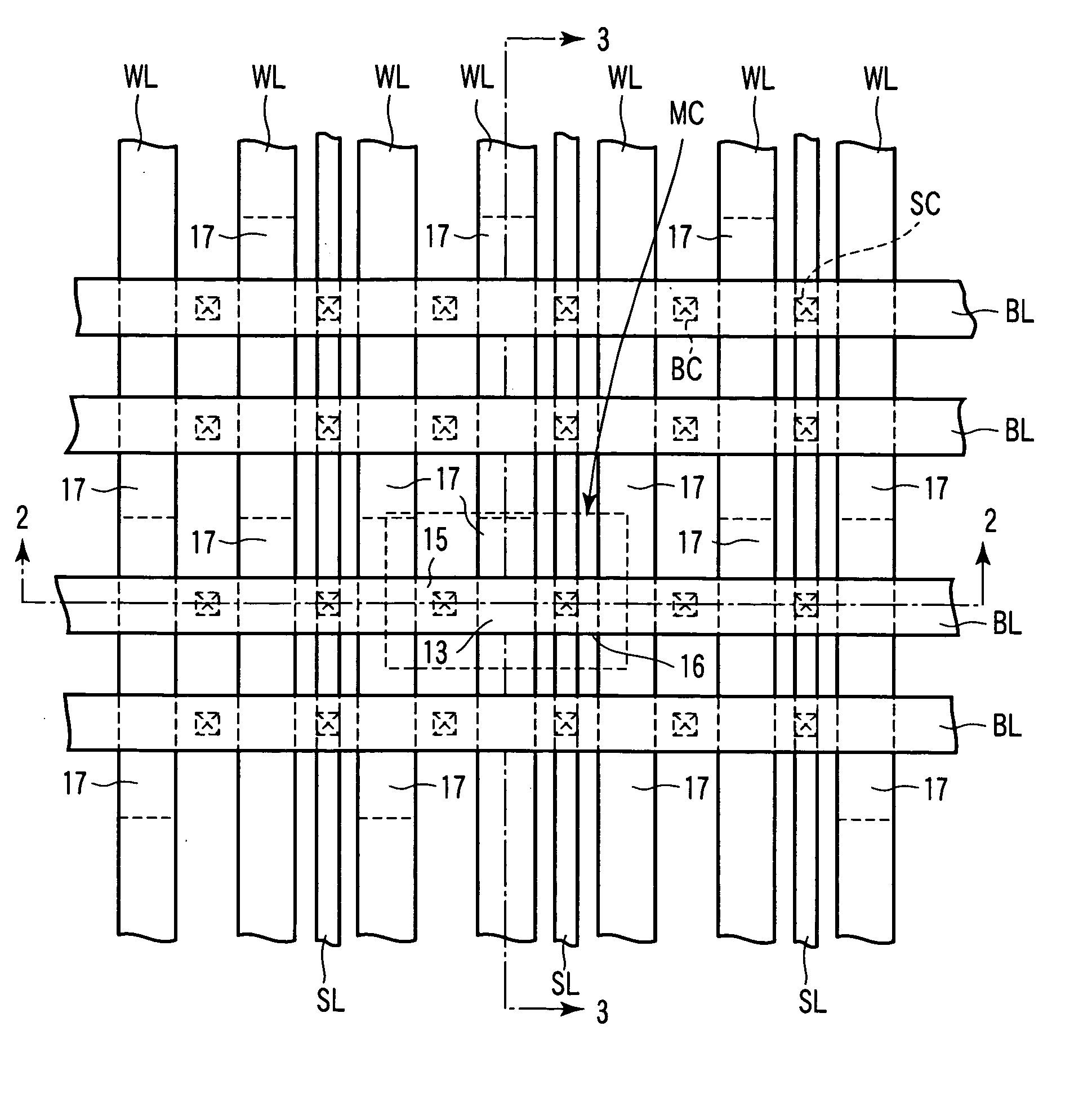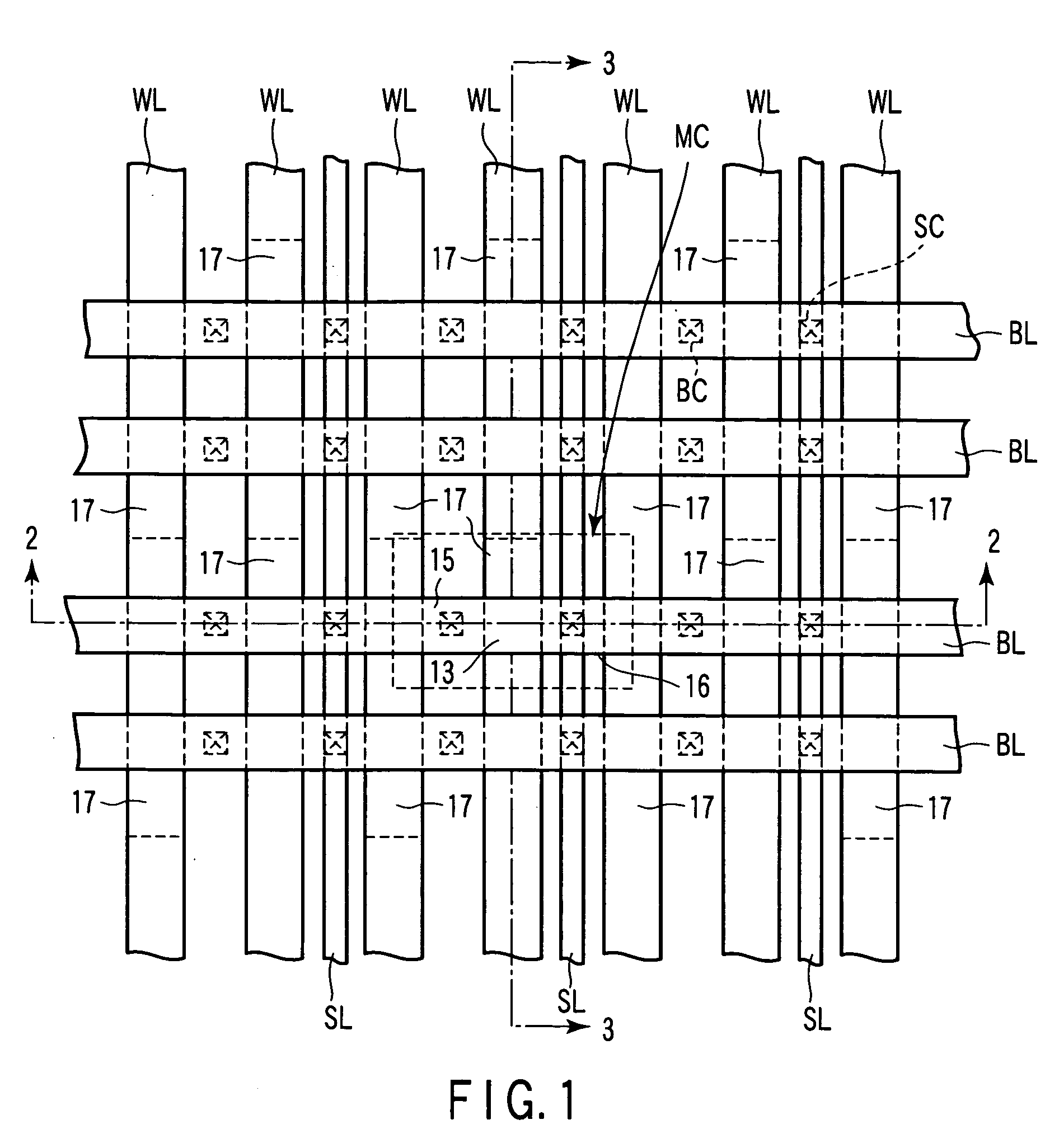Semiconductor memory device for dynamically storing data with channel body of transistor used as storage node
a memory device and transistor technology, applied in semiconductor devices, digital storage, instruments, etc., can solve the problems of unreasonable design of semiconductor devices, increased manufacturing costs, and reduced manufacturing yields
- Summary
- Abstract
- Description
- Claims
- Application Information
AI Technical Summary
Problems solved by technology
Method used
Image
Examples
first embodiment
[0040] First, a semiconductor memory device according to a first embodiment of this invention is explained with reference to FIGS. 1 to 3. The semiconductor memory device shown in FIGS. 1 to 3 is a so-called floating body cell (FBC) device and is a DRAM cell which uses the channel body of a transistor as a storage node to recognize data based on a difference in the current-voltage characteristic of the transistor caused by the potential of the storage node.
[0041]FIG. 1 is a plan view schematically showing one example of a memory cell array of the semiconductor memory device according to the first embodiment. FIG. 2 is a cross-sectional view taken along the 2-2 line of FIG. 1 and viewed in the arrow direction. FIG. 3 is a cross-sectional view taken along the 3-3 line of FIG. 1 and viewed in the arrow direction.
[0042] A portion surrounded by broken lines in FIG. 1 indicates a memory cell MC of one bit unit. The memory cells MC are respectively provided at intersections of word lines...
second embodiment
[0063] Next, a semiconductor memory device according to a second embodiment of this invention is explained with reference to FIGS. 4 to 6. In the following explanation, the repetitive explanation for the same portion as that of the first embodiment is omitted.
[0064]FIG. 4 is a plan view schematically showing one example of the semiconductor memory device according to the second embodiment. FIG. 5 is a cross-sectional view taken along the 5-5 line of FIG. 4 and viewed in the arrow direction. FIG. 6 is a cross-sectional view taken along the 6-6 line of FIG. 4 and viewed in the arrow direction.
[0065] As shown in FIGS. 4 to 6, memory cells MC are arranged at intersections of first word lines WL1 and bit lines BL. The memory cell MC surrounded by broken lines in FIG. 4 indicates one bit unit and the cell size is 16F2. Second word lines WL2 are arranged adjacent to the respective first word lines WL1 and formed to extend in the above direction. In other words, adjacent word lines of one...
third embodiment
[0074] Next, a semiconductor memory device according to a third embodiment of this invention is explained with reference to FIGS. 7 to 9. In the following explanation, the repetitive explanation for the same portion as that of the first and second embodiments is omitted.
[0075]FIG. 7 is a plan view schematically showing one example of the semiconductor memory device according to the third embodiment. FIG. 8 is a cross-sectional view schematically showing the semiconductor memory device taken along the 8-8 line of FIG. 7 and viewed in the arrow direction. FIG. 9 is a cross-sectional view schematically showing the semiconductor memory device taken along the 9-9 line of FIG. 7 and viewed in the arrow direction.
[0076] As shown in FIGS. 7 to 9, memory cells MC are arranged at intersections of first word lines WL1 and bit lines BL. The memory cell MC surrounded by broken lines in FIG. 7 indicates one bit unit and the cell size is 12F2. Second word lines WL2 and dummy word lines DL are ar...
PUM
 Login to View More
Login to View More Abstract
Description
Claims
Application Information
 Login to View More
Login to View More - R&D
- Intellectual Property
- Life Sciences
- Materials
- Tech Scout
- Unparalleled Data Quality
- Higher Quality Content
- 60% Fewer Hallucinations
Browse by: Latest US Patents, China's latest patents, Technical Efficacy Thesaurus, Application Domain, Technology Topic, Popular Technical Reports.
© 2025 PatSnap. All rights reserved.Legal|Privacy policy|Modern Slavery Act Transparency Statement|Sitemap|About US| Contact US: help@patsnap.com



